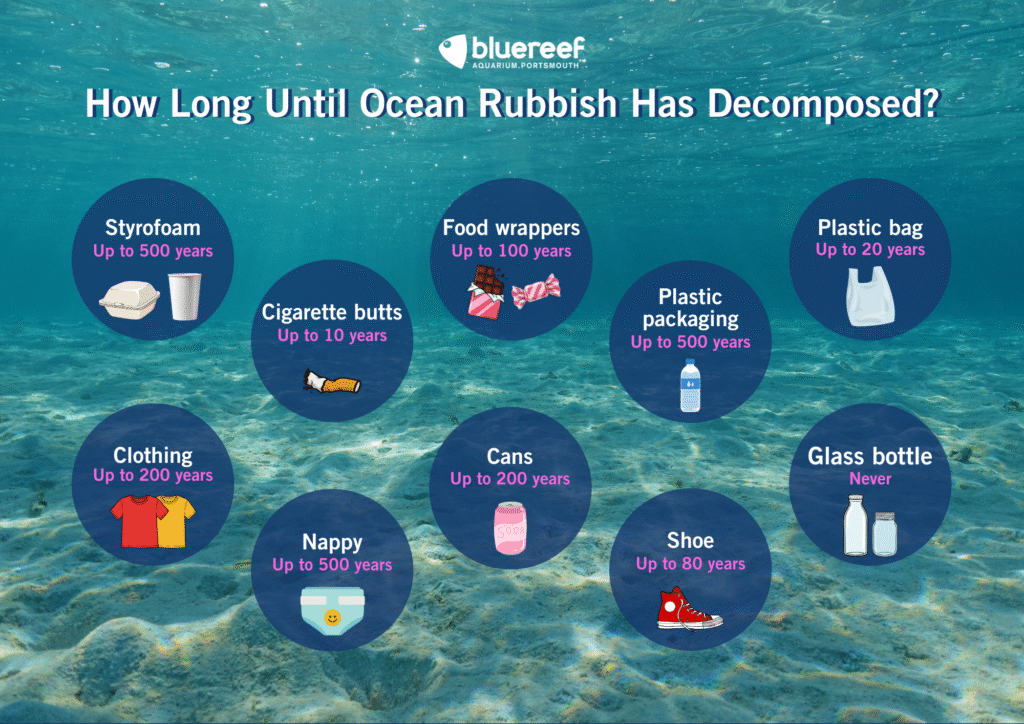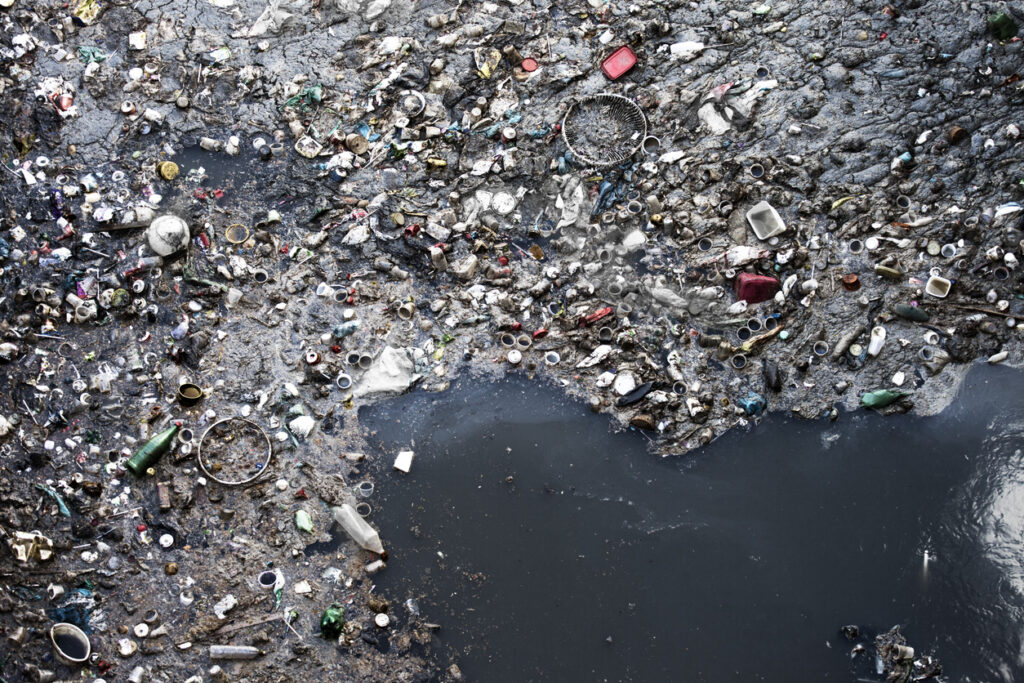Rubbish ends up in our oceans in various ways, but some of the most common reasons are littering and improper disposal of items. Since many materials can take years to decompose, this can cause problems that threaten marine conservation.
Approximately 5.25 trillion pieces of plastic are floating around on the surface of the sea. When these break down, they release harmful microplastics into the ecosystems and can seriously harm marine life of all kinds.
Litter doesn’t just disappear, either. Some items can take hundreds or even thousands of years to decompose. While it’s floating around, marine life will often mistake it for food or become entangled in it.
How much rubbish is in the ocean?
While it’s difficult to estimate the exact amount of rubbish in the ocean, it’s thought that there are around 5 trillion pieces of litter. This information is gathered through a number of different methods, including satellite imagery, AI cameras and using sampling data from scientific expeditions.
Some pieces might float on the surface, creating a hazard for birds and sea creatures that live near the surface. Other, heavier pieces of litter will sink, causing problems for deeper sea creatures and ecosystems.
Why ocean rubbish doesn’t decompose
Wondering why rubbish doesn’t just decompose in the water? It’s all down to the materials in the most common pieces of litter found on our beaches and in our oceans.
Plastic is one of the most commonly used materials and is manufactured to be incredibly durable. Unfortunately, this means that when items made from plastic end up in our oceans, they can take hundreds of years to fully decompose.
Metals like aluminium will corrode very slowly when submerged in water, so things like drinks cans can also float around for many years before fully breaking down.
Because these materials stick around for so long, they begin to accumulate in our oceans and along coastlines, leading to serious issues for marine life and their habitats.
Materials like cotton and paper, meanwhile, might break down faster, but they still cause harm to the surrounding environment as they decay because of the chemicals they contain.
How long does it take for rubbish to decompose in the ocean?
Find out how long it can take for different types of litter to fully decompose in our oceans with our poster below.

Want to find out how you can keep litter away from the ocean? Let’s learn more about some of the most common rubbish you might find in the ocean, why it takes so long to decompose and how this affects the marine life.
Plastic bags
Plastic bags can take up to 20 years to decompose.
Since plastic bags are light and floaty, they often drift through the water where sea turtles mistake them for jellyfish. They’re typically made from polyethylene, and if this is ingested by marine life such as turtles, it can block their stomachs and cause serious harm.
Food wrappers
Food wrappers can take up to 100 years to decompose.
Crisp packets and snack wrappers are made from layers of plastic and metal that decompose very slowly, taking decades or even centuries to decompose. Depending on how they’ve been manufactured, some might take less time, but this will still be around 10 years.
Many food wrappers are lightweight, which means they can easily be swept into the ocean by tides and wind. And because they’re usually shiny inside, they can often catch the attention of seabirds and fish, which mistake them for food. The danger here is that the wrappers can block their digestive systems.
Styrofoam
Styrofoam can take up to 500 years to decompose.
Styrofoam is frequently used for food containers and takeaway cups and is one of the most enduring types of litter. It breaks down into small white beads that float on the water’s surface, which fish, seabirds and turtles frequently mistake for food. The materials in styrofoam can’t be digested by marine organisms, so this is often fatal for them. Not only this, but the materials also release toxic chemicals into the water over time.
Plastic bottles and caps
Plastic bottles and caps can take up to 500 years to decompose.
Plastic bottles and other single-use plastics like plates and cups can float and travel across oceans for many years. Over time, they break down into tiny microplastics that fish and seabirds might accidentally eat. Plus, those small bottle caps can be swallowed whole, making them especially dangerous for young marine life.
Bottle caps are among the top littered items found on beaches worldwide, which makes this one of the most dangerous pieces of rubbish.
Cigarette butts
Cigarette butts can take up to 10 years to decompose.
Cigarette filters consist of a plastic known as cellulose acetate. When they end up in our waters, they can release dangerous chemicals such as nicotine and heavy metals, which can harm tiny marine organisms. Occasionally, birds and fish might ingest cigarette butts if they mistake them for food.
This is the most common form of litter found in beach clean-ups, which is why these are so important for conserving our beaches and oceans.
Clothing
Clothing can take up to 200 years to decompose.
Some clothing materials, like organic cotton and recyclable materials, might only take a few years to decompose. But with fast fashion items and clothes with a higher percentage of polyester in their composition, it can take hundreds of years.
Cans
Metal cans can take up to 200 years to decompose.
As metal cans corrode, they can leach small amounts of metal into the water
and as they corrode, they leach small amounts of metal into the water, which can be harmful to fish and shellfish. Many of these cans also feature sharp edges that can pose a danger to marine animals that are looking for food. Smaller creatures could even become trapped inside the cans.
Glass bottles
Glass bottles will never fully biodegrade.
If glass makes its way into our waters, it’ll never fully biodegrade. Over time, though, it’ll break down into smaller, sharper fragments which can injure animals and damage coral reefs.

The impact of rubbish on the ocean and marine life
Every piece of litter affects the food chain and habitat balance within our oceans. This problem can scale from the tiniest plankton to the largest whales, and in some cases, is a big part of why species are classified as endangered.
While you might just think of it as a single plastic bottle or a lost food wrapper, it can have a much wider impact on the ocean’s ecosystem.
How to prevent rubbish entering the ocean
Preventing rubbish from ending up in the ocean is the best way to protect our oceans and the ecosystems within them. So, here are some tips on how you can help in your everyday life:
- Limit the use of single-use plastics: Use reusable bottles, straws and shopping bags instead of single-use plastic products wherever possible.
- Dispose of rubbish correctly: Always dispose of rubbish in the correct bin, and if you can’t find one, take your rubbish home with you.
- Join local or school beach clean-ups: These are great for cleaning up local beaches and ensuring less rubbish ends up in the oceans.
- Choose products with less packaging: The less packaging that comes with your products, the better. It can’t end up in the ocean if it wasn’t there in the first place.
- Stay educated: Learn about recycling and composting, from the best practices to their benefits.
At Blue Reef Aquarium Portsmouth, we’re dedicated to supporting ocean conservation. From research and education to our conservation partnerships, we believe this work is more important now than ever before. To find out more about our conservation efforts and meet our wonderful animals, book your next visit here.
